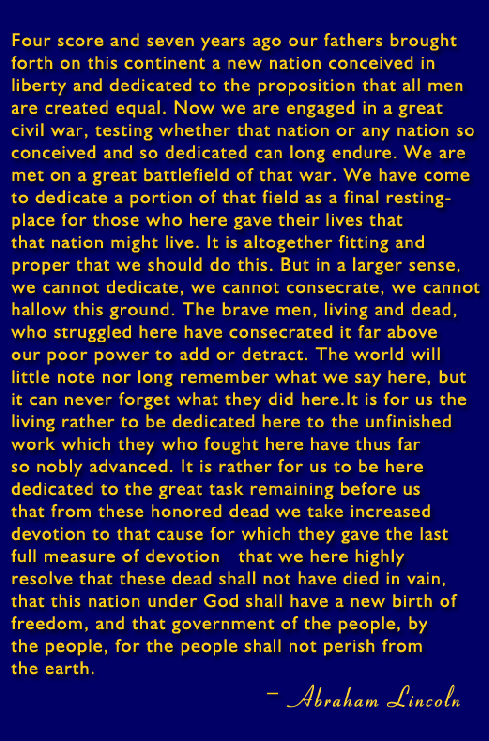


xxxxxAs we have
seen (1862),
whilst the Union forces met with success in the West -
THE AMERICAN CIVIL WAR
THE BATTLE OF GETTYSBURG -
Acknowledgements
Gettysburg: by the
Swedish-
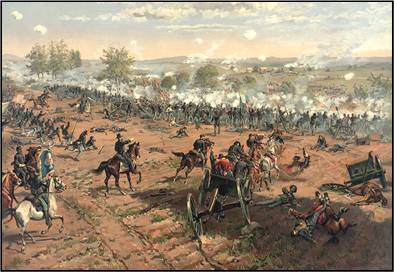 xxxxxAs we have seen,
during the opening years of the American Civil War, Union forces
in the West proved highly successful under the leadership of
General Ulysses Grant.
By June 1862
they had seized Memphis, Corinth and New Orleans, and their
victory at Vicksburg the following month meant that the
Confederation had been split down the middle, north to south. The
two sides were never to be reunited.
xxxxxAs we have seen,
during the opening years of the American Civil War, Union forces
in the West proved highly successful under the leadership of
General Ulysses Grant.
By June 1862
they had seized Memphis, Corinth and New Orleans, and their
victory at Vicksburg the following month meant that the
Confederation had been split down the middle, north to south. The
two sides were never to be reunited.
xxxxxHowever, in
the East the
Confederate army won the opening battles at Bull Run
and, despite their failure to capture the
Union capital of Washington, gained a major victory at the Battle
of Fredericksburg in December 1862, just before the onset of
winter. When fighting was resumed in April 1863 they gained a
further victory at the Battle of Chancellorsville, Virginia, and
decided to take the battle into the enemy’s heartland. Aiming to
penetrate as far as Philadelphia -
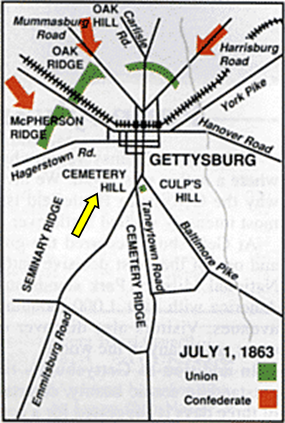
xxxxxThe battle
raged over the first three days of July 1863
and proved the longest and bloodiest encounter of the civil war.
On the first day, the fighting was centred around the outskirts of
Gettysburg with both sides manoeuvring to gain a favourable
position. Early on, Union cavalry and infantry occupied Herr
Ridge and McPherson Ridge, low rangese to the north-
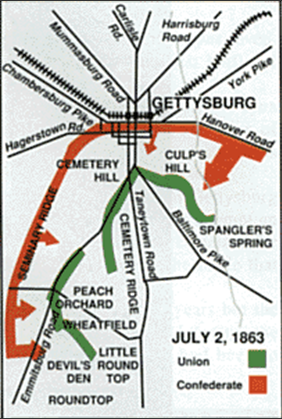 xxxxxBy the next day both armies were up to their full
strength. Lee opened the fighting by launching a series of attacks
upon both flanks of the Federal line. On the left flank there was
fierce fighting around a series of strategic points. Peach Orchard
was captured and held for a time, but the Confederate forces
failed to take Devil’s Den and were driven back in a ferocious
battle for Little Round Top, a rocky hill at the southern end of
Cemetery Ridge. The
general failure of the Confederate forces was due in part to a
lack of coordination on the part of the field commanders. This
gave time for the Union forces to be reinforced by some 20,000
men. Towards the end of the encounter, the Southerners were being
outflanked by elements of the Union army and were forced to
retire, suffering heavy losses in the process. On the Union right
a number of attacks were mounted on Cemetery Hill and Culp’s Hill,
but despite many casualties the defenders held their lines. At one
time Confederate troops did reach the crest of Cemetery Ridge, but
were then thrown back by a desperate counter attack.
xxxxxBy the next day both armies were up to their full
strength. Lee opened the fighting by launching a series of attacks
upon both flanks of the Federal line. On the left flank there was
fierce fighting around a series of strategic points. Peach Orchard
was captured and held for a time, but the Confederate forces
failed to take Devil’s Den and were driven back in a ferocious
battle for Little Round Top, a rocky hill at the southern end of
Cemetery Ridge. The
general failure of the Confederate forces was due in part to a
lack of coordination on the part of the field commanders. This
gave time for the Union forces to be reinforced by some 20,000
men. Towards the end of the encounter, the Southerners were being
outflanked by elements of the Union army and were forced to
retire, suffering heavy losses in the process. On the Union right
a number of attacks were mounted on Cemetery Hill and Culp’s Hill,
but despite many casualties the defenders held their lines. At one
time Confederate troops did reach the crest of Cemetery Ridge, but
were then thrown back by a desperate counter attack.
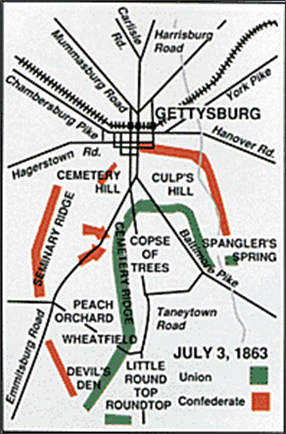 xxxxxThe third day opened with seven hours of fierce
fighting around Culp’s Hill. The Confederates were again unable to
break through the Union lines, but in the afternoon Lee, confident
that one further push would win the day, ordered a massed infantry
assault upon Cemetery Ridge. Following a prolonged artillery
pounding of the Union’s position -
xxxxxThe third day opened with seven hours of fierce
fighting around Culp’s Hill. The Confederates were again unable to
break through the Union lines, but in the afternoon Lee, confident
that one further push would win the day, ordered a massed infantry
assault upon Cemetery Ridge. Following a prolonged artillery
pounding of the Union’s position -
xxxxxThe Battle
of Gettysburg, together -
xxxxxNonetheless,
after Gettysburg and Vicksburg (fought in the same week) the
Confederacy was forced more and more on the defensive. Itxdid manage to win a number of battles (such as the Battle of
Chickamauga in September 1863), but its
hopes of winning an outright victory became more and more unlikely. By 1864 the advantages held by
the Union, such as its supremacy in industrial output, manpower,
and means of transport, were beginning to tell. Strategically,
this allowed Grant to get the better of Lee in a series of bloody
battles in Virginia in the summer of 1864, fought mainly in
Shenandoah Valley. The Confederates won a number of engagements,
but could ill-
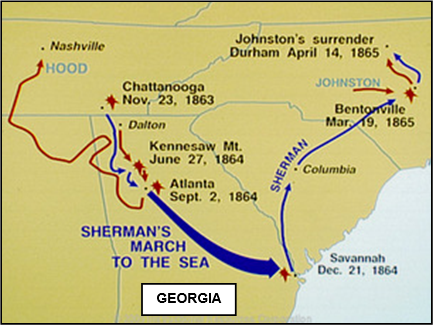
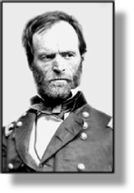 xxxxxMeanwhilexin the West,
starting with the Union victory at the Battle
of Chattanooga in November 1863, and
finishing with the Battle of Nashville in December 1864, the Confederates were forced out
of Tennessee. In the meantime, General
William T. Sherman (1820-
xxxxxMeanwhilexin the West,
starting with the Union victory at the Battle
of Chattanooga in November 1863, and
finishing with the Battle of Nashville in December 1864, the Confederates were forced out
of Tennessee. In the meantime, General
William T. Sherman (1820-
xxxxxBy 1865, Lee had been forced to retreat to Richmond, his capital in Virginia, whilst in the west the Confederacy had virtually collapsed, hastened by the Union’s decision to grant freedom to the slaves of the Deep South. As we shall see, formal surrender came in April 1865, signed in the McLean House at Appomattox Courthouse between the Confederate commander Robert E. Lee and the Union commander Ulysses S. Grant. The civil war was over, but its cruel consequences were about to begin.
xxxxxIncidentally, the civil war was also fought, albeit on a small scale, west of the Mississippi River. There, Confederate troops attempted to take over Arizona and New Mexico, but were driven out in 1862. Texas was in Confederate hands throughout the war, but could play little part in the conflict after the Union gained control of the Mississippi following the Battle of Vicksburg in July 1863. ……
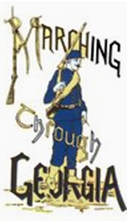
xxxxx…… Thexsong Marching
Thru’ Georgia was composed by the American songwriter Henry Clay Work (1832-
xxxxx…… Itxwas during the Civil War, in November 1864, that about 800 Union soldiers, mostly irregulars, went on the rampage and destroyed a friendly village of Cheyenne and Arapaho at Sand Creek in Kiowa County, Colorado. Some 200 Indians were killed, nearly all children and elderly men and women. An official enquiry condemned the Massacre at Sand Creek, but no one was arrested, and the memorial at Colorado Capitol lists the event as one of the Union’s great victories.
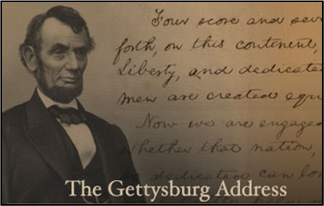 xxxxxIt was in November 1863 that President Abraham Lincoln gave his now
famous Gettysburg Address at a ceremony held to dedicate the battlefield as a
military cemetery. Thexmain speaker for
this occasion, the celebrated politician Edward
Everett of Massachusetts -
xxxxxIt was in November 1863 that President Abraham Lincoln gave his now
famous Gettysburg Address at a ceremony held to dedicate the battlefield as a
military cemetery. Thexmain speaker for
this occasion, the celebrated politician Edward
Everett of Massachusetts -
xxxxxAt the time of the ceremony, Lincoln’s few, brief words were received without applause and left many of the 15,000 audience totally unimpressed, but over the years this carefully crafted address, delivered with feeling and compact in thought, has become the most celebrated speech in the history of the United States. And in addition, it has proved an inspiration to people across the world who have attained or seek to attain a government “of the people, by the people and for the people”.
Including:
The Gettysburg
Address

Vb-
